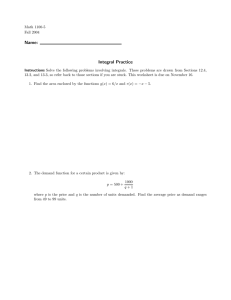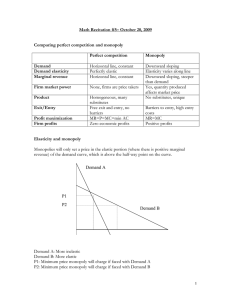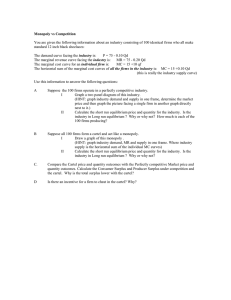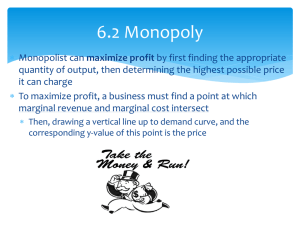EC1000 Microeconomics Exam Paper - University of Leicester
advertisement
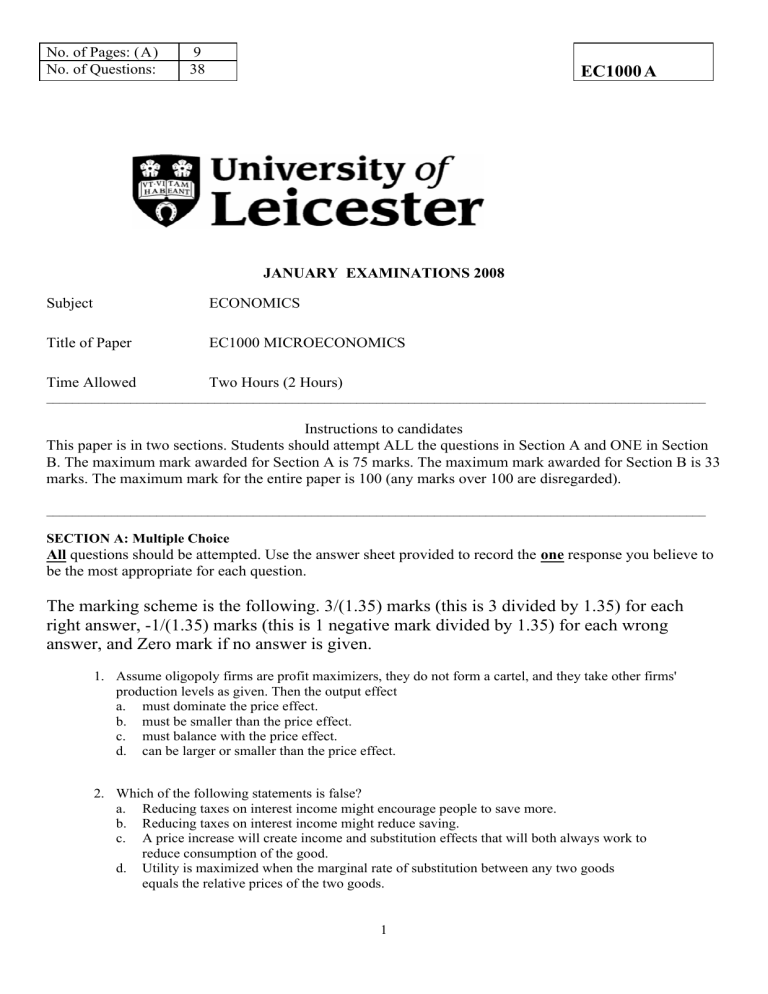
No. of Pages: (A) No. of Questions: 9 38 EC1000 A micro 2008 JANUARY EXAMINATIONS 2008 Subject ECONOMICS Title of Paper EC1000 MICROECONOMICS Time Allowed Two Hours (2 Hours) ______________________________________________________________________________________________________ Instructions to candidates This paper is in two sections. Students should attempt ALL the questions in Section A and ONE in Section B. The maximum mark awarded for Section A is 75 marks. The maximum mark awarded for Section B is 33 marks. The maximum mark for the entire paper is 100 (any marks over 100 are disregarded). ______________________________________________________________________________________________________ SECTION A: Multiple Choice All questions should be attempted. Use the answer sheet provided to record the one response you believe to be the most appropriate for each question. The marking scheme is the following. 3/(1.35) marks (this is 3 divided by 1.35) for each right answer, -1/(1.35) marks (this is 1 negative mark divided by 1.35) for each wrong answer, and Zero mark if no answer is given. 1. Assume oligopoly firms are profit maximizers, they do not form a cartel, and they take other firms' production levels as given. Then the output effect a. must dominate the price effect. b. must be smaller than the price effect. c. must balance with the price effect. d. can be larger or smaller than the price effect. 2. Which of the following statements is false? a. Reducing taxes on interest income might encourage people to save more. b. Reducing taxes on interest income might reduce saving. c. A price increase will create income and substitution effects that will both always work to reduce consumption of the good. d. Utility is maximized when the marginal rate of substitution between any two goods equals the relative prices of the two goods. 1 EC1000 A - Microeconomics I EC1000 A 3. When the marginal product of labor falls, the marginal cost of output a. falls, then rises. b. becomes negative. c. rises. d. remains constant. Figure 8-5 4. Refer to Figure 8-5. If a tax is imposed in this market, the price buyers would now pay for the good would be a. $2. b. $6. c. $10. d. $16. 5. The production possibilities frontier is a downward-sloping straight line when the a. opportunity cost of producing each good depends on the amount produced. b. technology of production is constant. c. opportunity cost of producing each good is independent of the amount of the good produced. d. economy is industrialized. 6. When one person uses a common resource and he diminishes other people's enjoyment of it, it is an example of a. a market force. b. an externality. c. the invisible hand. d. excludability. 7. If the elasticity of supply is zero, then a. supply is very elastic. b. the supply curve is horizontal. c. the quantity supplied is the same regardless of price. d. Both b and c are correct. 2 EC1000 A - Microeconomics I EC1000 A 8. It is commonly argued that national defense is a public good. Nevertheless, the weapons used by the U.S. military are produced by private firms. We can conclude that a. resources would be used more efficiently if the government produced the weapons. b. resources would be used more efficiently if private firms provided national defense. c. weapons are rival and excludable but national defense is not rival and not excludable. d. who can most efficiently provide a good does not depend on concepts such as rivalry or excludability. Figure 4-7 9. Refer to Figure 4-7. At a price of $35, a. a shortage would exist and the price would tend to fall. b. a surplus would exist and the price would tend to rise. c. a surplus would exist and the price would tend to fall. d. the market would be in equilibrium. 10. Which of the following would NOT be considered a private good? a. tennis shoes b. pizza c. french fries d. cable TV 11. The phenomenon of product differentiation contrasts sharply with the phenomenon of a. homogeneous products. b. industrial products. c. monopolistic competition. d. product integration. 12. Which of the following statements is correct? a. A competitive firm is a price maker and a monopoly is a price taker. b. A competitive firm is a price taker and a monopoly is a price maker. c. Both competitive firms and monopolies are price takers. d. Both competitive firms and monopolies are price makers. 3 EC1000 A - Microeconomics I EC1000 A Table 3-4 U.S. Japan Hours needed to make one unit of: Cars Airplanes 40 160 50 150 Amount produced in 2400 hours: Cars Airplanes 60 15 48 16 13. Refer to Table 3-4. The opportunity cost of 1 car for the United States is a. 4 airplanes. b. 3 airplanes. c. 1/3 airplane. d. 1/4 airplane. 14. Which of the following goods are sold in a monopolistically competitive market? a. compact discs b. wheat c. corn d. postage stamps 15. The Tragedy of the Commons a. occurs most often with public goods. b. is only applicable to shared grazing rights among sheep herders. c. is eliminated when property rights are assigned to individuals. d. occurs when social incentives are in line with private incentives. 16. Economists normally assume that the goal of a firm is to a. maximize its total revenue. b. maximize its profit. c. minimize its explicit costs. d. minimize its total cost. 17. Which of the following determines a market supply curve but not an individual supply curve? a. number of sellers b. expectations c. input prices d. technology 18. In the long run, a firm that produces and sells computers gets to choose a. how many workers to hire. b. the size of its factories. c. which short-run average-total-cost curve to use. d. All of the above are correct. 4 EC1000 A - Microeconomics I EC1000 A 19. An industry is a natural monopoly when (i) government assists the firm in maintaining the monopoly. (ii) a single firm owns a key resource. (iii) a single firm can supply a fixed number of goods or services at a smaller cost than could two or more firms. a. b. c. d. (i) only (iii) only (i) and (ii) (ii) and (iii) 20. Which of the following would NOT be correct concerning government attempts to reduce the flow of illegal drugs into the country? a. Drug interdiction raises prices and total revenue in the drug market. b. Drug interdiction can increase drug-related crime. c. Drug interdiction shifts the supply curve of drugs to the left. d. Drug interdiction shifts the demand curve for drugs to the left. 21. As a result of free trade in a commodity, the a. price of the commodity must be the same in all countries. b. total quantity imported will exceed the total quantity exported. c. price of the commodity will be higher in the producing country. d. price of the commodity will be lower in the producing country. Figure 9-5 22. Refer to Figure 9-5. When a tariff is imposed in the market, producers a. gain by $100. b. gain by $200. c. gain by $300. d. lose by $100. 5 EC1000 A - Microeconomics I EC1000 A Figure 8-2 23. Refer to Figure 8-2. The equilibrium price before the tax is a. P1. b. P2. c. P3. d. None of the above are correct. 24. Joe's Garage operates in a perfectly competitive market. At the point where marginal cost equals marginal revenue, ATC = $20, AVC = $15, and the price per unit is $10. In this situation, a. Joe's Garage will break even. b. Joe's Garage will shut down immediately. c. Joe's will lose money in the short run, but stay in business. d. the market price will fall in the short run. 25. When demand is unit elastic price elasticity a. exactly equals 1 and total revenue does not change when price changes. b. exactly equals 1 and total revenue and price move in opposite directions. c. exactly equals 1 and total revenue and price move in the same direction. d. approaches infinity and total revenue does not change when price changes. 26. Generally, a firm would be able to respond most to a change in price in a. one month. b. six months. c. one year. d. five years. 27. Suppose that the equilibrium quantity in the market for widgets has been 200 per month. Then a tax of $5 per widget is imposed on widgets. The price paid by buyers increases by $2 and the after-tax price received by sellers falls by $3. The government is able to raise $750 per month in revenue from the tax. The deadweight loss from the tax is a. $250. b. $125. c. $75. d. $50. 6 EC1000 A - Microeconomics I EC1000 A Market Supply and Demand for Pepperoni Pizza Table 7-4 PRICE QUANTITY DEMANDED QUANTITY SUPPLIED $12.00 $10.00 $ 8.00 $ 6.00 $ 4.00 $ 2.00 0 4 8 12 16 20 12 10 8 6 4 2 28. Refer to Table 7-4. At a price of $4.00, total surplus would be a. more than it would be at the equilibrium price. b. less than it would be at the equilibrium price. c. the same as it would be at the equilibrium price. d. There is insufficient information to say. Use the following information to answer the following questions. Adrian's Premium Boxing Service subcontracts with a chocolate manufacturer to box premium chocolates for their mail order catalogue business. She rents a small room for $150 a week in the downtown business district that serves as her factory. She can hire workers for $275 a week. Table 13-2 Number of Workers 0 1 2 3 4 5 6 Chocolates Produced per Week Marginal Product of Labor Cost of Factory 330 150 Cost of Workers Total Cost of Inputs 0 275 425 150 825 975 60 10 1,375 630 890 950 1,800 29. Refer to Table 13-2. During the week of July 4th, Adrian doesn't box any chocolates. What are her costs during the week? a. 0 b. 150 c. 275 d. 425 30. The opportunity cost of current household consumption is the a. wage rate. b. market interest rate. c. price of the goods consumed. d. explicit cost of consumption. 7 EC1000 A - Microeconomics I EC1000 A 31. If Roberta sells a shirt for $30, and her producer surplus from the sale is $21, her cost must have been a. $51. b. $30. c. $21. d. $9. 32. An increasing marginal product of labor would be most commonly found a. at high levels of employment. b. in perfect competition. c. at low levels of employment. d. when prices are rising. 33. When evaluating differences or similarities between an increase in supply and an increase in quantity supplied we know that a. the former is a shift of the curve and the latter is a movement along the curve. b. the former is a movement along the curve and the latter is a shift of the curve. c. both are shifts of the supply curve. d. both are movements along the curve. 34. Which of the following practices would indicate that an employer is trying to overcome a moral-hazard problem with respect to his employees? a. The employer pays his workers wages that are unusually high for the industry and region. b. The employer has voluntarily removed video cameras from the factory floor. c. The employer has discontinued the practice of giving his employees' year-end bonuses. d. All of the above are correct. SECTION B Answer one and only one of the questions numbered 35 to 38. Do NOT answer more than one question from this section. The maximum number of marks awarded for this Section is 33. 35. Answer both parts (a) One example of price discrimination occurs in the publishing industry when a publisher initially releases an expensive hardcover edition of a popular novel, and later releases a cheaper paperback edition. Use this example to demonstrate the benefits and potential pitfalls of a price discrimination pricing strategy. (b) Briefly contrast the difference between equilibrium market outcomes in a monopoly, oligopoly, and perfect competition. 8 EC1000 A - Microeconomics I EC1000 A 36. Answer both parts (a) When the Shaffers have a monthly income of $4,000, they would usually eat out 8 times a month. Now that the couple makes $4,500 a month, they eat out 10 times a month. Compute the couple's income elasticity of demand using the midpoint method. Explain your answer. (Is a restaurant meal a normal or inferior good to the couple?) (b) Why might economists prefer private ownership of monopolies over public ownership of monopolies? 37. Answer both parts (a) The production function depicts a relationship between which two variables? Also, draw a production function that exhibits diminishing marginal product. (b) Use a graph to demonstrate the circumstances that would prevail in a competitive market where firms are earning economic profits. Can this scenario be maintained in the long run? Carefully explain your answer. 38. Using the graph shown, assume that free trade existed in this country before the government imposed an import quota of 20 hammers. Answer the following questions given this information. In each case, carefully explain your answers. a. b. c. d. e. f. g. h. i. What is the price of hammers before the quota is imposed? What is the price of hammers after the quota is imposed? What is the quantity of hammers imported before the quota? What is the quantity of hammers imported after the quota? What is the amount of consumer surplus before the quota? What is the amount of consumer surplus after the quota? What is the amount of producer surplus before the quota? What is the amount of producer surplus after the quota? What would be the amount of deadweight loss due to the quota? 9 ID: A micro 2008 Answer Section MULTIPLE CHOICE 1. 2. 3. 4. 5. 6. 7. 8. 9. 10. 11. 12. 13. 14. 15. 16. 17. 18. 19. 20. 21. 22. 23. 24. 25. 26. 27. 28. 29. 30. 31. 32. 33. 34. C C C D C B C C C D A B D A C B A D B D A C B B A D B B B B D C A A 1 ID: A SHORT ANSWER 35. (a) The answer should address the three basic lessons of price discrimination. First, price discrimination is a rational strategy that can lead to higher monopoly profits. Second, price discrimination requires an ability to separate customers according to their willingness to pay. Third, price discrimination can raise economic welfare. (b) Let: PC = Perfect Competition O = Oligopoly M = Monopoly QPC > QO > QM PM > PO > PPC 36. (a) The income elasticity of demand for the Shaffers is 1.89. Since the income elasticity of demand is positive, this would be interpreted as a normal good. (b) The private monopolist is governed by the market. Even though the market solution is sub-optimal, it may be better than outcomes generated by publicly owned monopolies. Publicly owned monopolies may restrict output to levels below the private market outcome and thus generate an even lower level of social surplus than a private profit-maximizing monopolist. They also may not work to reduce costs. 37. (a) It depicts a relationship between output and a given input. The graph should show output increasing, but at a decreasing rate as inputs increase. (b) In a competitive market where firms are earning economic profits, new firms will have an incentive to enter the market. This entry will expand the number of firms, increase the quantity of the good supplied, and drive down prices and profits. 2 ID: A 38. a. b. c. d. e. f. g. h. i. P2 P3 Q4 -Q1 20 (or Q3 - Q2) A+B+C+D+E'+E"+F A+D G G+B C+F 3
